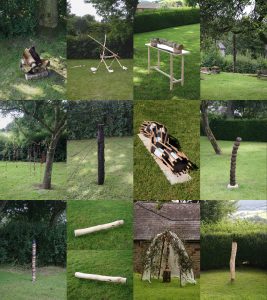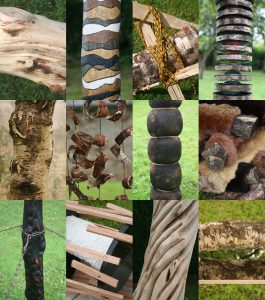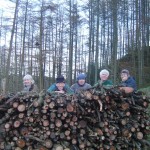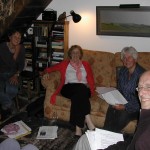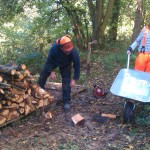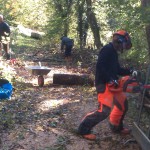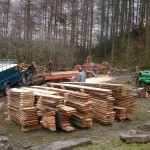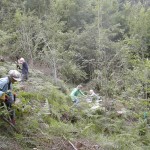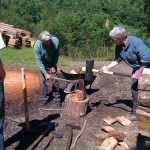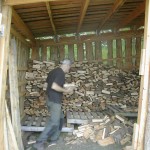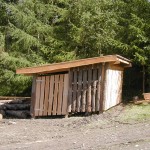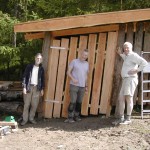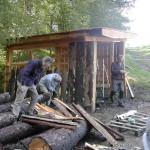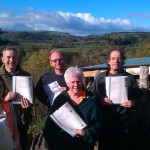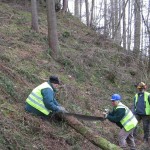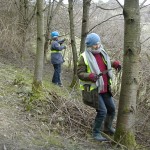We are a group of volunteers who manage woodlands for the benefit of wildlife and our members. We come together once a week to share and learn skills at our woodland Task Days, during which we manage woodland sustainably, allowing our members access to affordable woodland products such as firewood and timber. KCWG is a separately constituted organisation that grew from Teme Valley Environment Group, who generously still host our web presence.
See our regular Twitter and Facebook posts and our Woodlanders’ Update newsletters (below) for news of our latest activities!
News
Woodlanders’ Update
Woodlanders’ Update is our regular mini-newsletter to keep volunteers, members and supporters up-to-date. We will keep the last 3 issues posted here but if you’d like to be added to the distribution list please email us at woodland@tveg.org.uk
Woodland Task Days continue … and we are still seeking home-based volunteers
Our woodland task days continue, as we carry out seasonal activities in local woodlands, so we would welcome enquiries from potential woodland-based volunteers. We are also seeking a range of home-based volunteers to help us grow as an organisation.
We are looking for volunteers with the skills we need to expand and put our organisation on a more sustainable footing. Perhaps you have recently retired, or moved to the area, and are looking to use your skills to benefit the environment and the local community? We need volunteers like you with skills in wildlife surveys, fundraising, marketing, sales and ICT. And we always need people for woodland task days – with or without woodland skills as we can teach you what you need to know.
If you would like to know more about these volunteering opportunities, please have a look at the role descriptions below:
Volunteer Biodiversity Surveyor role description
Market Research and Sales Volunteer
If you are interested in these roles, please contact us via woodland@tveg.org.uk or on 01547 520374 for an informal chat.
Our current programme.
We go out to local woodlands one day a week to carry out seasonal woodland management activities such as felling, coppicing, charcoal making or cutting logs. We alternate between Thursdays and Sundays, and volunteers choose how much of the day to stay for. Volunteers work at their own pace and we provide all the tools and training needed. So, come and learn new skills while helping local wildlife. For more information on the task days, and to find out how to join in, please contact us via email woodland@tveg.org.uk or telephone 01547 520374.
Trees need to be coppiced (cut back almost to ground level then re-grown), felled or planted when they are dormant. We need to be careful not to disturb nesting birds. For these reasons, most work on trees is carried out in autumn and winter. Summer is a time of cutting cordwood (4-foot-long pieces of wood) into logs, preparing for winter work, making charcoal and weeding around newly planted trees.
Our task day programme is below and can be downloaded as a pdf document: Task Programme April 2024 to September 2024
Please note that task day dates are subject to change and that factors such as bad weather can prevent task days from going ahead. We also sometimes need to adjust the programme to meet the requirements of volunteers and woodland owners. Always contact us before going to a wood to ensure that a task day is going ahead as planned.
All task days will run from 9.30am to approximately 2.30pm.
Sunday, 7 April 2024
Thursday, 11 April 2024
Sunday, 21 April 2024
Thursday, 25 April 2024
Sunday, 5 May 2024
Thursday, 9 May 2024
Sunday, 19 May 2024
Thursday, 23 May 2024
Sunday, 2 June 2024
Thursday, 6 June 2024
Sunday, 16 June 2024
Thursday, 20 June 2024
Sunday, 30 June 2024
Thursday, 4 July 2024
Sunday, 14 July 2024
Thursday, 18 July 2024
Sunday, 28 July 2024
No August task days
Sunday, 1 September 2024
Thursday, 5 September 2024
Sunday, 15 September 2024
Thursday, 19 September 2024
Sunday, 29 September 2024
Log Stack Extraordinaire
Steve, a Woodlander volunteer, has been busy in his garden, as he writes here…
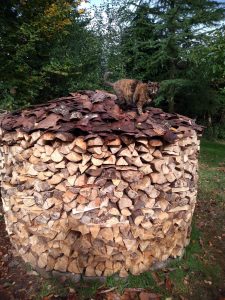 Sometime ago I saw an article online about Holzhausen, a traditional freestanding log-stacking method popular in Bavaria and Scandinavia, where they sometimes build them to huge dimensions and hold competitions focusing on artistic designs. After letting my curiosity mature for a number of years, I have finally got round to constructing my own. I am pleased with the result to the extent that it will be a shame to break it up when it comes time to use the firewood!
Sometime ago I saw an article online about Holzhausen, a traditional freestanding log-stacking method popular in Bavaria and Scandinavia, where they sometimes build them to huge dimensions and hold competitions focusing on artistic designs. After letting my curiosity mature for a number of years, I have finally got round to constructing my own. I am pleased with the result to the extent that it will be a shame to break it up when it comes time to use the firewood!
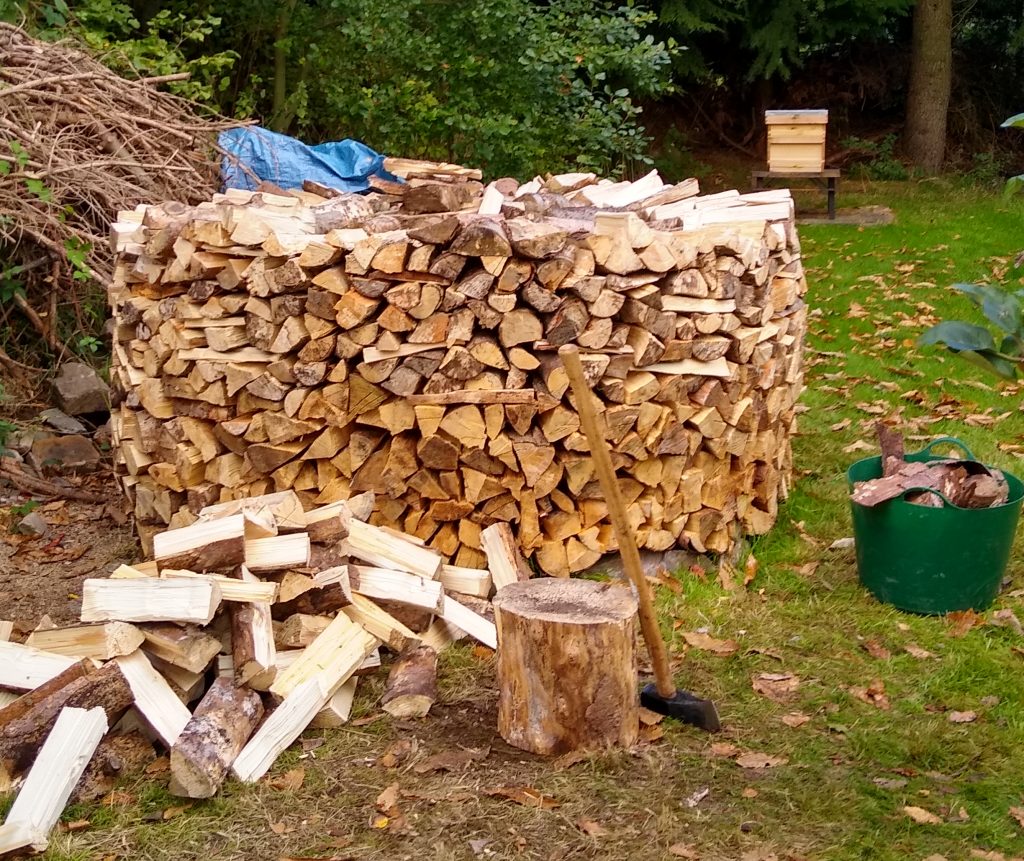 I stuck to the most basic ‘beehive’ design using a mixture our own pine thinnings and hardwoods from the Woodlanders, all topped with a triple layer of bark. There has been a number downpours since completion and it appears that the stack sheds rain extremely well. Being free standing, the Holzhausen saves the effort of constructing a frame or other support required by a standard stack, though it probably takes a little more time to construct the stack itself.
I stuck to the most basic ‘beehive’ design using a mixture our own pine thinnings and hardwoods from the Woodlanders, all topped with a triple layer of bark. There has been a number downpours since completion and it appears that the stack sheds rain extremely well. Being free standing, the Holzhausen saves the effort of constructing a frame or other support required by a standard stack, though it probably takes a little more time to construct the stack itself.
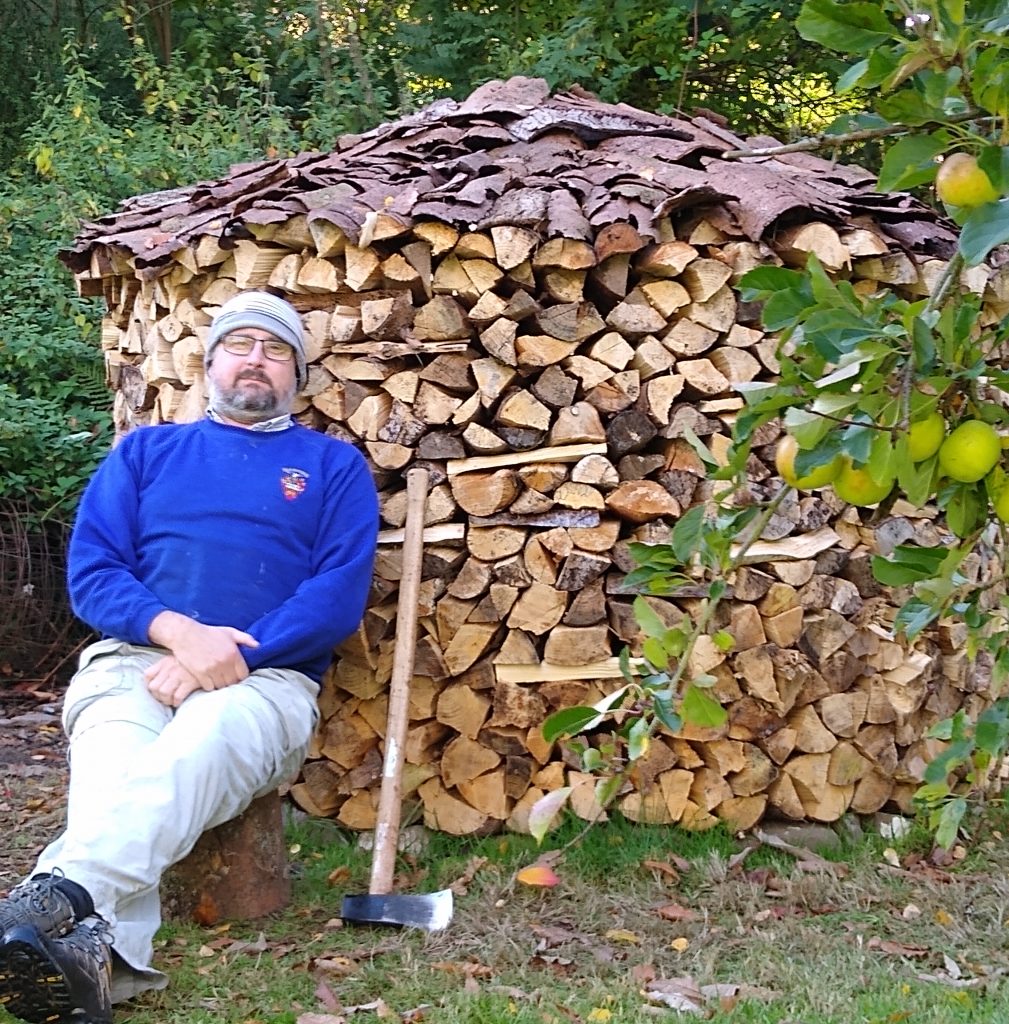 The Holzhausen contains a surprising amount of wood; over 2 cords (approx. 7 cubic meters) in this example, which is almost 6 feet high and 8 in diameter. I did find that any smaller diameter presented problems as the curve of the outer wall was too abrupt to easily stack the wood. Another advantage is that once the outer walls are taking shape, the centre can be filled with any offcuts or hard to split pieces that do not fit easily in a standard stack. Apparently, the stack should act as a low-level oven with air flowing into the centre through gaps in the outer wall and rising through the centre of the stack, wicking away moisture. It is claimed this can lead to a faster curing rate and firewood thoroughly dried and seasoned in only ten months, though whether this applies in the Welsh climate remains to be seen!
The Holzhausen contains a surprising amount of wood; over 2 cords (approx. 7 cubic meters) in this example, which is almost 6 feet high and 8 in diameter. I did find that any smaller diameter presented problems as the curve of the outer wall was too abrupt to easily stack the wood. Another advantage is that once the outer walls are taking shape, the centre can be filled with any offcuts or hard to split pieces that do not fit easily in a standard stack. Apparently, the stack should act as a low-level oven with air flowing into the centre through gaps in the outer wall and rising through the centre of the stack, wicking away moisture. It is claimed this can lead to a faster curing rate and firewood thoroughly dried and seasoned in only ten months, though whether this applies in the Welsh climate remains to be seen!
If you like Steve’s work, we recommend Norwegian Wood by Lars Mytting, available from your local independent bookshop (or library).
Out of the Wood Exhibition
The Out of the Wood exhibition was held at the at the Bleddfa Centre in Bleddfa. Charlie, a Woodlander volunteer, organised the exhibition, giving each of the sculptors a piece of 4-foot birch cordwood to do with as they pleased. As you can see, the results were varied and wonderful!
Why I Volunteer…
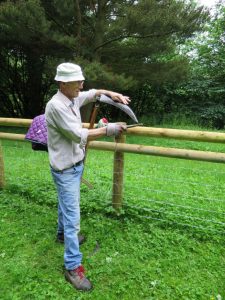 A founding member, Colin may have attended more task days than anyone!
A founding member, Colin may have attended more task days than anyone!
Back in 2010, I met a group of local residents who, like me, were concerned about the number of woodlands falling into neglect, or that trees were treated just like a cash crop and whole swathes of them were clearfelled, devastating the habitats of the species that used to live there. As a result, Knighton Tree Allotments Trust (now known as Knighton Community Woodlands Group) was created and this was my opportunity to help bring some woodlands back into sustainable management whilst improving biodiversity. I have thoroughly enjoyed seeing the group grow in those ten years, have visited and worked in a variety of woodlands, attended various training courses, developed new skills, helped in the creation of woodland products and enjoyed meeting and working with the other volunteers and woodland owners.
For more years than I care to remember, I have always enjoyed being involved in practical conservation. Whilst in employment, the experience of working out in the fresh air and benefitting from the exercise was a happy escape from sitting by a computer screen in an office. Now retired, trying to keep fit and meeting others is even more essential and volunteering with KCWG helps towards meeting those needs. Most of us lead busy lives and it’s nice to know that no regular commitment is required. You can do as much or as little as you like … and the big bonus is on those cold, winter evenings as the fruits of all our labours repays our efforts. As the old saying goes, wood warms you three times – when you cut it, when you split it, and when you burn it and to that I would like to add the warm feeling you get when you know you’ve done something positive for nature.
You can read more of our volunteer stories here: Why I Volunteer articles
About Knighton Community Woodlands Group
It is a common misconception that unmanaged woodland is always best for wildlife. In fact, unmanaged woodlands lose species over time as the canopy remains closed and the woodland floor stays dark. Large animals, like bison and wild cattle, used to keep woodlands dynamic and open but they are now extinct. Through traditional practices such as coppicing, we bring light back into the woodland, increase the variety of habitats and increase the richness of wildlife.
In ensuring that the trees that we fell for fuel or timber are replaced with new plants, we are creating a sustainable supply of woodland products. By sustainably growing firewood and other woodland products we can displace fossil fuel use and reduce our carbon footprint. At the same time we are joining co-operatively with other local people to enjoy, conserve and enrich our local environment.
So why, as a conservation group, do we cut down trees? There are several reasons for this. First of all, sometimes we are simply harvesting a crop. Most broadleaved trees, when coppiced (cut almost to ground level), will vigorously re-grow and can be harvested again in a few years. How many years depends on the site conditions and what size of wood you need: beanpoles grow in 3 to 4 years, firewood takes 8 to 15 years. Trees can last for centuries being cut like this. Sometimes we want to give certain trees more space and light, so we fell the trees around them to enable them to grow larger and fatter. At other times you might have a whole woodland of trees the same age – a plantation – where, like in a vegetable garden, you have sown or planted more trees than you need in order to later select the best and strongest to grow on to maturity. It might be that a tree is so damaged, e.g. by grey squirrels, deer or weather, that it is removed to give the remaining trees more light. Although we also deliberately leave dead trees standing as they provide a good home for birds, bats, bugs and fungi.
Trees need to be planted, coppiced or felled when they are dormant. We also need to be careful not to disturb nesting birds. For these reasons, most woodland work is carried out in autumn and winter. From October to March each year, we are concentrating solely on harvesting through coppicing hazel and thinning trees (i.e. reducing their number). By coppicing a different part of the woodland each year we will be increasing the variety of habitats and allowing more light to the woodland floor in the areas that we cut. We are also thinning some trees to favour others – for example hazel coppice – and to increase the diversity of trees in a wood.
Summer is a time of clearing up from our winter work, making charcoal, keeping newly planted trees free from weeds and cutting logs.
Ways to get involved…
We are always looking for people who would like to learn about woodland management and ecology. Volunteering is a great way to meet like-minded people. We need help with hands-on woodland management such as tree planting, firewood processing, and flora and fauna surveys. You can get plenty of fresh air and exercise while learning new skills. We also need volunteers to help with administrative tasks such as fundraising, marketing, sales, ICT, etc. To find out more, or for an informal chat, please contact us via woodland@tveg.org.uk or 01547 520374.
If you would like to register as a volunteer please use one of the forms below, whichever is easiest for you: we have provided Microsoft Word and pdf formats. KCWG Volunteer Registration Form (MS Word) KCWG Volunteer Registration Form (pdf). Once you have registered as a volunteer you will receive regular emails about forthcoming task days and other events.
You could also join us as a Member. When you become a member you get a say in how the Trust is run; you can help decide the policies that guide how we operate. You’ll also become part of an active community of like-minded people who are working towards sustainable development. If you attend our AGM you can vote for someone to represent your views as a Trustee or stand for election yourself – it’s a great chance to represent your fellow members. Membership costs just £10 a year and you can join using one of the forms below, whichever is easiest for you: we have provided Microsoft Word and pdf formats. KCWG Membership Form (MS Word) KCWG Membership Form (pdf)
More about Knighton Community Woodlands Group
There are a number of other documents of interest that we have had a role in producing:
A Landowner’s tips for voluntary woodland organisations
Understanding Woodland Management
Managing Woodlands for added value
Processing and Stacking Firewood
Running Knighton Community Woodlands Group
We currently have three Committee Members who have taken on various responsibilities: Nicola Colston, Brendan Rogers (Secretary) and Jean Littler.
We are always keen to hear from people who have relevant skills and experience that they would like to offer us, perhaps by becoming a Committee Member. If you feel that you can help us in the sustainable management of local woodlands for the benefit of wildlife and our members, please contact the Company Secretary, Brendan Rogers via our email address: woodland@tveg.org.uk
Each year we hold an Annual General Meeting (AGM) where Members, Committee Members and Volunteers come together to find out how we are doing and to decide on our next steps. Members of KCWG vote for the Committee Members who make the day-to-day decisions on behalf of the Members. Our AGM for 2023 was held at Knighton Community Centre on 27th June 2023 at 7.30pm and a report can be found here: KCWG Annual Report June 2023
To find out what was discussed and decided at previous meetings please follow the links below.
Our AGM for 2022 was held online on Tuesday 8th February 2022 at 7.30pm and a report can be found here: KCWG Annual Report February 2022
Our AGM for 2020 was held online on Wednesday 2nd December 2020 at 7.30pm and a report can be found here: KCWG Annual Report December 2020
Our AGM for 2019 was held on Monday 24th June 2019 at Knighton Community Centre at 7.30pm and a report can be found here: Annual Report June 2019.
Our AGM for 2018 was held on Thursday 17th May 2018 at Knighton Community Centre at 7.30pm and a report can be found here Annual Report for 2018.
Looking after Wildlife
Our aim is to “manage woodlands for the benefit of wildlife and our members”. But how do we know that we are achieving this? We carry out flora and fauna surveys, the results of which can be found here.
Greenstreete Bird Survey – April 2016
Greenstreete Bird Survey – Sept 2015 Greenstreete Bird Survey – June 2015
Baselines Flora and Fauna Surveys at Greenstreete 2013 Greenstreete Bird Survey November 2013 Greenstreete Bird Survey – May 2013 Greenstreete Moth Surveys 2013
Greenstreete Bird Survey – Dec 2012
Some of the activities you can be part of by volunteering!

